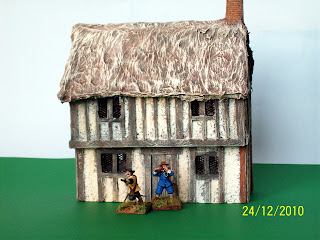One half of my dragoon regiment was made up from a pack of Renegade Miniatures mixed mounted and foot figures. I have reviewed those separately, here. The other half of the regiment, including all the command figures (officer, ensign with guidon and drummer) came from Redoubt Enterprises. Overall, the anatomy on the Redoubt figures is very good, and they are nicely proportioned – they are roughly the shape of normal people, which is rather a difference to the Renegade examples! Sizewise they matched to Renegade and the larger ranges of figures, rather than Perry / TAG / Warlord for example.
The figures come with armoured or unarmoured heads, which you select which at the time of ordering. Redoubt’s website works well and delivery is good. My figures have arrived after a couple of weeks, which to a person brought up on “please allow twenty eight days for delivery” is perfectly adequate. The armoured heads are all in three-barred helmets, which aren’t terribly appropriate for dragoons, so I went with soft hats except for the commander, to further set him apart from the rest of the rabble. The clothing is varied, well sculpted and appears authentic, based on the sources I have. All except the drummer have swords moulded in place. These are relatively simple “mortuary swords” or tucks, and are totally suitable for the figures. In neither the foot nor the mounted figures does the ensign get a flagstaff. I’m not sure what the correct terminology here is – “real” cavalry have Cornets, and apparently dragoons used a similar type of staff, but the flag was, even at this time, a swallow-tailed guidon. However, I’ve never heard of the flag bearer referred to as a “Guidon”!
None of the human figures, mounted or foot, suffer from any real amount of flash. There is a little around the arms, but this wafer thin and easily removed. Mould lines are easily removed with knife or burnisher. The metal used is quite soft and given the small amount of work required, drastic tools like coarse files and Dremel burrs are totally unnecessary.
The separate heads are easy to fit. The “necks” are overlong, and need cutting down to the appropriate length. This is facile with a side cutter. Interestingly enough, all of the mounted figures fit ALL of the horses without any additional modification! This is really quite unusual, as some mounted figures I have bought required significant chopping of horse and rider to achieve a decent fit. I milled a bit of metal from the standard bearer’s coat to improve the fit but this was more in the nature of fettling than serious metalwork.
One slight hiccup is that the figures have carbines, not muskets, in many cases. Dragoons really ought to have muskets, not carbines. I’m not sure if this indicates that the figures are actually cavalry doing double duty as dragoons, but I haven’t let it spoil my day. I left the foot figures carrying carbines as they were, but decided that the mounted men really ought to be put right.

The task was relatively simple. Cut away the existing forestocks and barrels, drill into the hands and replace with new barrels made of steel wire. I then added a thin layer of green stuff to the forestock and butt, to build up the initial bulk, and to give the barrel some support. When this was dry, additional green stuff was used to build up the musket. Ramrods were modelled from the green stuff forming the forestock, barrel bands were created by incising the putty with a scalpel and lockwork, where necessary, was added at the end. The results can be seen in the photo. When I get a bit further, I’ll add some further pictures.









